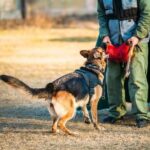One of the most common behavior problems dog owners face is separation anxiety. This problem can be caused by many factors, such as a lack of socialization, prior abuse, or anxiety caused by changes in the family dynamic (e.g. the addition of a new baby, pet, or family member).
There are many ways to help your dog overcome separation anxiety, but the most important step is to be consistent with your training. The following tips will help you get started:
1. Start by gradually increasing the amount of time you spend away from your dog. Begin with just a few minutes and work your way up to longer periods of time.
2. Make sure your dog has a place to relax and feel safe when you’re not home. This could be a crate, bed, or designated spot in the house.
3. Leave a few toys or treats with your dog to keep them occupied while you’re gone.
4. Make sure your dog gets plenty of exercise and stimulation throughout the day. A tired dog is less likely to experience anxiety when left alone.
5. Be positive and upbeat when leaving your dog, and avoid showing any signs of anxiety yourself. This will only make your dog more anxious.
6. If your dog exhibits signs of separation anxiety (e.g. barking, chewing, urinating/defecating indoors), calmly and quietly correct them without making a big fuss. This will help them associate your departure with something positive.
7. Reward your dog for good behavior when you return home. This will help reinforce the positive associations they’ve made with being away from you.
8. If you have to leave your dog for an extended period of time, consider hiring a pet sitter or taking them to a kennel. This will help reduce the amount of stress they experience.
Separation anxiety can be a difficult problem to overcome, but with patience and consistency, you can help your dog overcome their anxiety and lead a happy, healthy life.
Can You Train Anxiety Out Of A Dog
?
Yes, you can train anxiety out of a dog. It is not always easy, and it may take some time and patience, but it can be done. The most important thing is to be consistent in your training and to be patient.
There are a number of things you can do to help train your dog to be less anxious. One of the most important is to provide your dog with plenty of exercise. A tired dog is a relaxed dog. You should also provide your dog with plenty of positive reinforcement. Reward your dog for calm and relaxed behavior, and ignore any anxious behavior.
You can also help your dog to relax by providing a calm and safe environment. Make sure your dog has a comfortable place to sleep and plenty of toys to play with. Avoid stimulating environments, like busy streets or loud restaurants, and make sure your dog has plenty of opportunities to relax.
If your dog is still struggling with anxiety, you may want to consider consulting a professional dog trainer. They can help you to develop a training program specifically tailored to your dog’s needs.
How To Train Dog For Anxiety
The first step to training a dog for anxiety is to identify the source of their anxiety. This can be done by taking your dog to a veterinarian or a behavior specialist. Once the source has been identified, a treatment plan can be created.
There are a variety of treatments available for anxiety in dogs, including medication, behavior modification, and environmental changes. The most important part of treating anxiety is to be consistent with the treatment plan.
If your dog is taking medication for anxiety, it is important to continue giving them the medication as prescribed, even if they seem to be doing better. Behavioral modification may include teaching your dog new commands or redirecting their behavior. Environmental changes may include adding new toys or treats to their environment, or changing the way you interact with them.
If you are not sure how to train your dog for anxiety, it is best to consult a behavior specialist. They can help create a treatment plan that is specific to your dog’s needs and will help them overcome their anxiety.
Can You Train A Dog To Not Have Separation Anxiety
?
Dogs that experience separation anxiety can be a handful. They may bark, whine, or even urinate and defecate when their guardians leave them alone. Some dogs become so anxious that they damage property or injure themselves in an attempt to reunite with their guardians.
So, can you train a dog to not have separation anxiety? The answer is yes and no. You can’t train a dog to never experience separation anxiety, but you can train a dog to better cope with being left alone.
The key to helping a dog with separation anxiety is to slowly increase the amount of time the dog spends alone. Start with just a few minutes and work up to longer periods of time. During this training period, it’s important to leave the dog with a toy or a treat to keep them occupied.
You can also help your dog to cope with separation anxiety by teaching them how to stay calm when you leave. When you’re getting ready to leave, give your dog a cue, such as “stay” or “watch me,” and then leave the room. Once your dog is calm, you can release them from the cue.
It’s important to be patient and consistent when training a dog with separation anxiety. With time and patience, you can help your dog to better cope with being left alone.
How To Train A Dog To Sense Anxiety
Dogs are capable of sensing when their owners are feeling anxious or stressed out. In fact, dogs are so good at it that they can even be trained to respond to these signals. If you are the owner of a dog who seems to be especially attuned to your anxiety levels, here are a few tips on how to train your dog to sense anxiety.
The first step is to be aware of the signals that your dog is sending you. Some of the most common signals that dogs give when they are sensing anxiety in their owners include lip licking, yawning, turning their head away, and cowering. Once you have become aware of these signals, you can start training your dog to respond to them.
The best way to do this is to start by rewarding your dog when they display one of the anxiety-sensing signals that you have identified. When your dog licks their lips, for example, give them a treat. Do this every time they display the signal, and soon they will start to associate the behavior with getting a treat.
You can also start conditioning your dog to respond to the sound of your anxiety. If you tend to get especially anxious when you are home alone, for example, start playing recordings of your own anxiety-filled voice when you are not home. Once your dog has learned to associate the sound of your anxiety with getting a treat, they will start to react to it by displaying one of the anxiety-sensing signals.
It is important to note that it may take some time for your dog to fully understand what it is that you are asking them to do. Be patient and keep rewarding your dog for their efforts, and eventually they will be able to sense when you are feeling anxious and will start to respond accordingly.

Welcome to the blog! I am a professional dog trainer and have been working with dogs for many years. In this blog, I will be discussing various topics related to dog training, including tips, tricks, and advice. I hope you find this information helpful and informative. Thanks for reading!





